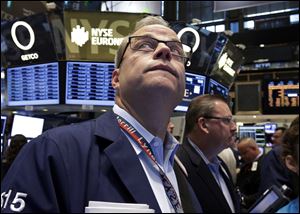
China slump, higher bond yields weigh on markets
6/24/2013
Major stock indexes finished down for the day.
NEW YORK -- More signs of distress in China’s economy and rising bond yields led to a broad sell-off in stocks Monday, leaving the market down 5.7 percent from its all-time high last month.
It’s the first pullback of 5 percent or more since November.
U.S. trading started with a slump Monday. The market recovered much of its loss, then fell back toward steeper losses again. By the close of trading the big stock indexes were clinging to modest gains for the second quarter. The last day of trading for the quarter is Friday.
Things were rough for stock investors in the morning. An overnight plunge in China caused by a spike in lending rates led to declines in Europe. China’s Shanghai Composite Index fell 5 percent, its biggest decline in four years. The drop was prompted by a government crackdown on off-balance sheet lending, which made investors worry about China’s economic growth. Then France’s benchmark stock index fell 1.7 percent, Germany’s 1.2 percent.
U.S. traders took one look at that and sold. The Dow Jones industrial average fell as much as 248 points in the first hour of trading. The yield on the 10-year Treasury note spiked to its highest in almost two years as the sell-off brought down prices of U.S. government debt. Gold and other metals also fell.
Stocks got closer to break-even around midday before falling again in the last hour. The Dow finished down 139.84 points, or 0.9 percent, at 14,659.56. The S&P 500 index fell 19.34 points, or 1.2 percent, to 1,573.09. The Nasdaq dropped 36.49 points, or 1.1 percent, to 3,320.76.
All 10 industry groups in the S&P 500 fell. The biggest drop was 1.8 percent for bank and financial stocks. Bank of America fell the most among major bank stocks, giving up 39 cents, or 3.1 percent, to $12.30.
Getting reliable information out of China is difficult, so it takes investors longer to decide how to react to developments there, said Gary Thayer, chief macro strategist for Wells Fargo Advisors.
The turbulence is also another a sign of how vulnerable financial markets remain to any comments from the Fed about its $85 billion in monthly bond purchases, which have kept interest rates at historic lows and helped drive the stock market’s rally the last four years. On Wednesday and Thursday, the S&P plunged 3.9 percent after the central bank said its bond-buying program could wrap up by the middle of next year as long as economic conditions continue to improve. Stocks edged up Friday, but still had their worst week in two months.
“I think investors are overreacting to the prospects of a change in Fed policy,” Thayer said. He noted that unemployment is down, inflation is low. “These are good economic conditions.”
Gold fell $14.90, or 1.2 percent, to $1,277.10. Other metals were down, too. Crude oil rose $1.49, or 1.6 percent, to $95.18 per barrel.
Pullbacks that occur during bull markets tend to be “nasty and brutish” — but short, said John Manley, chief equity strategist at Wells Fargo Funds Management. He said it’s common to get declines of 3 percent to 7 percent “as the market restores a reverence to risk to the investing public.”
The last time the U.S. stock market had a full-blown correction — defined as a drop of at least 10 percent from a peak — was July 22-Oct. 3, 2011, when the S&P 500 fell 18.3 percent. That fall was caused by concern that a fight between U.S. lawmakers over extending the debt ceiling would push the U.S. into default.
Since starting its bull run in March 2009, the S&P 500 has had six pullbacks of between 5 and 9 percent and two corrections. So far, the market has come back stronger from each setback. The S&P is still up 133 percent during this four-year bull market.
“Pullbacks are a natural occurrence in markets,” said Janet Engels, senior vice president and director of the private client research group at RBC Wealth Management. “We likely have further to go.”
The yield on the 10-year note rose slightly to 2.55 percent. Earlier in the day it was at 2.67, its highest level in almost two years. The yield has surged from its 2013 low of 1.63 percent on May 3. The increase accelerated last week after the Federal Reserve laid out the possible timetable for curtailing its bond-buying program. Yields rise when demand for bonds weakens.
The Fed’s easy-money policies have kept bond yields and other interest rates artificially low since the financial crisis of 2008, making borrowing cheaper. The 10-year yield is used as a benchmark for many kinds of loans to individuals and businesses, including home mortgages.
The last time the yield was above 3 percent was late July, 2011. The last time it was consistently above 4 percent was July 2008, two months before the peak of the financial crisis.
Other stocks with big moves included:
— PulteGroup slumped 50 cents, or 2.7 percent, to $18.31. Investors have worried that higher U.S. interest rates will hurt homebuilding companies by making mortgages more expensive.
— Tenet Healthcare rose $1.88, or 4.5 percent, to $43.73 after offering to buy Vanguard Health Systems Inc. for $1.8 billion. The offer of $21 per share pushed Vanguard stock up $8.33, or 67 percent, to $20.70.
— Facebook fell 60 cents, or 2.4 percent, to $23.93. Monday was the first full trading day after Facebook acknowledged it had accidentally exposed contact information for 6 million users to some other users.
— Apple fell $10.96, or 2.7 percent, to $402.50 after an analyst said the company appears to have cut back iPhone production. The company didn’t have any immediate comment.